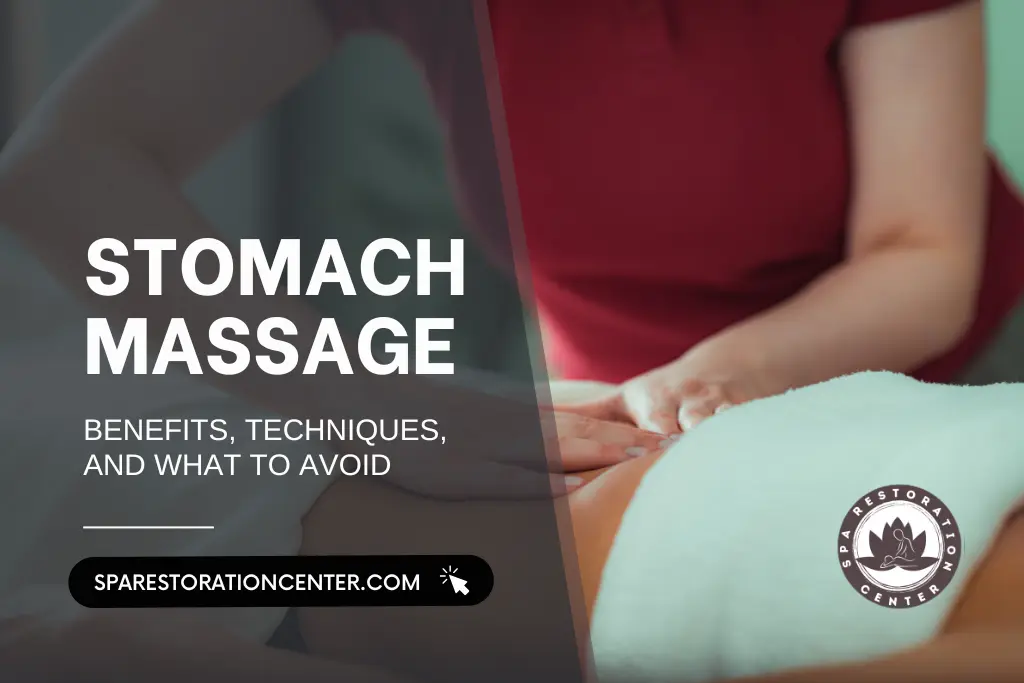
Stomach Massage: Benefits, Techniques, and What to Avoid
Stomach massage is a gentle and relaxing way to support digestion, relieve bloating, and ease discomfort from gas or cramps. It can bring relief while promoting overall health, whether you’re addressing digestive issues or just looking for a calm, restorative practice.
In this guide, you’ll learn:
- Stomach massage techniques for constipation
- Techniques for lymphatic drainage
- Methods to relieve gas and bloating
- Techniques that support digestion
- Stomach massage approaches for weight loss
- Safety tips and precautions to avoid discomfort
Using these stomach massage techniques regularly may ease bloating, relieve gas or cramps, and help your digestive system function more smoothly.
What is Abdominal Massage (or Stomach Massage):
Abdominal massage, also called stomach massage, is a gentle technique. It uses light pressure and circular movements on the stomach area. The goal is to stimulate digestion, reduce tension, and support overall abdominal health.
You can do it on yourself or have a trained therapist perform it. The massage targets muscles, organs, and connective tissues in the abdomen. This helps improve blood flow, relax muscles, and support digestive function.
Abdominal massage is often used to:
- Reduce bloating and gas
- Ease constipation
- Support lymphatic drainage
- Improve digestion and nutrient absorption through effective belly massage techniques.
- Relieve menstrual or stomach cramps
- Promote relaxation and well-being
It is a simple, safe practice. Doing it regularly can improve comfort and digestive health.
Benefits of Abdominal Massage
Stomach massage does more than just feel good. Regular practice can improve digestion, relieve discomfort, and support overall wellness. Some key benefits include reducing chronic pain and easing muscle tension.
- Improves digestion: Gentle massage stimulates the digestive organs, helping to smooth bowel movements and better nutrient absorption.
- Relieves constipation: Massaging the abdomen encourages bowel activity and reduces constipation discomfort.
- Reduces gas and bloating: Targeted massage helps release trapped gas and eases bloating.
- Supports lymphatic drainage: Moves lymph fluid through the body, aiding detoxification and reducing swelling.
- Eases menstrual cramps and abdominal pain: Gentle pressure relaxes muscles and reduces pain from cramps or digestive discomfort.
- Aids weight management: Regular massage can boost metabolism and improve circulation in the stomach area.
- Promotes relaxation: Activates the parasympathetic nervous system, helping reduce stress and anxiety.
Adding stomach massage to your routine provides both physical relief and mental calm. It’s a simple, effective way to improve comfort and overall health.
Stomach Massage Techniques
Stomach massage can help with digestion, bloating, gas, and overall comfort. Doing it regularly can make your stomach feel lighter and more relaxed. Here are the main techniques:
1. Stomach Techniques for Constipation
Constipation can cause pain and bloating, which may be alleviated through targeted belly massage. Gentle massage helps move the bowels naturally, making passing stool easier and relaxing the stomach, which can also alleviate trigger points.
How to do it:
- Use gentle, circular motions on the lower abdomen to support bowel function and relieve tightness.
- Move clockwise, following the path of the colon, to maximize the effects of abdominal massage.
- Apply light to moderate pressure, taking care to knead any areas of tension.
Benefits: Relieves constipation and eases discomfort.
Tip: Consider the benefits of abdominal massage for overall wellness. Incorporate deep breathing while performing self-massage for enhanced relaxation. Massage in a quiet, calm setting.
2. Stomach Techniques for Lymphatic Drainage
The lymphatic system removes toxins and extra fluid, supporting overall muscular health. Massage can improve lymph flow and reduce swelling. Slow, gentle strokes help fluids move toward lymph nodes.
How to do it:
- Use slow, sweeping motions from the center outward.
- Move fluid toward the lymph nodes on the sides.
- Keep pressure gentle to avoid exacerbating any existing chronic pain.
Benefits: Supports detox and reduces fluid retention.
Tip: Breathe slowly while massaging.
3. Stomach Methods to Relieve Gas and Bloating
Gas and bloating make the stomach tight and uncomfortable. Massage helps release trapped gas and relax muscles, giving quick relief.
How to do it:
- Apply gentle circular pressure around the stomach.
- Move clockwise to help move gas.
- Relax the abdominal muscles.
Benefits: Reduces bloating and eases discomfort.
Tip: Drink warm water after a massage.
4. Stomach Techniques That Support Digestion
Massage can improve digestion and nutrient absorption. It helps food move smoothly and reduces cramps. Regular practice keeps your digestive system active.
How to do it:
- Use soft, rhythmic circles over the abdomen.
- Massage just below the ribs to stimulate digestion.
- Perform daily for best results.
Benefits: Improves digestion and reduces discomfort.
Tip: Massage before meals to wake up your stomach.
5. Stomach Massage Approaches for Weight Loss
Massage can boost circulation and metabolism. It may help tone the abdominal area. Combining massage with diet and exercise works best.
How to do it:
- Use firm, circular strokes around the stomach and sides, similar to techniques employed by a massage therapist.
- Improve blood flow and stimulate metabolism.
- Combine with a healthy diet and exercise.
Benefits: Supports metabolism and tones muscles.
Tip: Use oils like ginger or grapefruit for extra stimulation.
Safety Tips and What to Avoid During Belly Massage
While stomach massage is generally safe, it’s important to take precautions to prevent discomfort or injury. Follow these tips for a safe and effective massage:
Dos:
- Use gentle pressure: Start lightly and increase only if comfortable.
- Massage clockwise: Follow the natural path of your digestive system.
- Keep movements slow and steady: Avoid rushing or aggressive rubbing.
- Stay relaxed: Take deep breaths to help your muscles and digestive organs relax.
- Use oil or lotion: Reduces friction and makes the massage smoother.
Don’ts:
- Avoid massage after heavy meals: Wait at least 1–2 hours after eating.
- Don’t massage if you’re pregnant without consulting a doctor.
- Avoid if you have abdominal injuries or have had surgery recently.
- Don’t massage over swollen, bruised, or painful areas.
- Avoid excessive pressure; it can cause pain or internal strain.
Tip: If you experience sharp pain, nausea, or dizziness during massage, stop immediately and consult a healthcare professional.
Following these safety tips ensures your stomach massage is effective, relaxing, and risk-free.
Is Abdominal Massage Dangerous?
Abdominal massage is generally safe when done correctly. Most people can benefit from a gentle, regular massage without problems. However, there are some situations where it can be risky.
Potential risks include:
- Recent surgery or injury: Massaging too soon can cause pain or complications.
- Pregnancy: Some techniques may not be safe without professional guidance.
- Abdominal pain or swelling: Massaging over inflamed areas can worsen issues.
- Medical conditions: People with heart problems, hernias, ulcers, or severe digestive disorders should consult a doctor first.
Tips to stay safe:
- Always use gentle pressure.
- Avoid massaging if you feel severe pain or discomfort.
- Stop immediately if you feel dizziness, nausea, or sharp pain.
- When in doubt, ask a healthcare professional before starting abdominal massage.
When practiced mindfully, abdominal massage is a safe and effective way to support digestion, reduce bloating, and promote relaxation.
Take Care of Your Stomach with Spa Restoration Center & Head Spa
Bloating, gas, and slow digestion can make your stomach uncomfortable. Stomach massage helps relieve pain and support digestive health. Our self-massage techniques can help alleviate muscle tension. Lymphatic drainage stomach massage reduces fluid retention and eases tension.
At Spa Restoration Center & Head Spa in Arlington, VA, our therapists tailor each session to your needs. Improve circulation, reduce bloating, and feel lighter with gentle, effective abdominal massage.
Take care of your stomach today and enjoy a healthier, more comfortable you!



Leave a comment